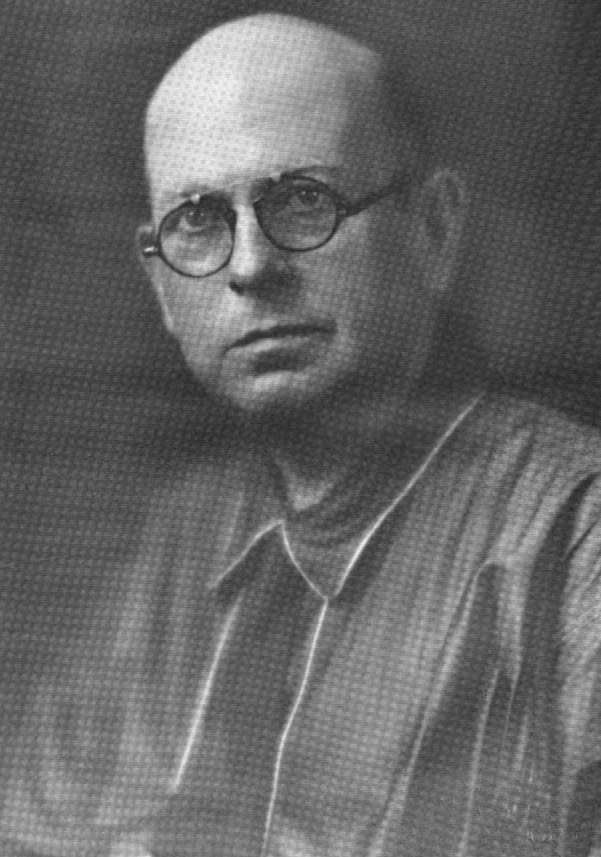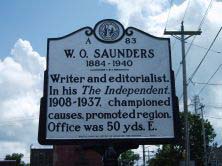May 24, 1884–April, 25 1940

William Oscar Saunders, newspaper editor, politician, and spokesman on state and national affairs, was born at Goodman’s Mill Pond in Perquimans County. He was one of six children—two sons and four daughters—of Mary Ella Byrd and John Robinson Saunders. A few years after his birth the family moved to the town of Hertford, where his father opened a small store. Saunders did not receive any formal education, but he did attend the common school in the village during his youth.
In an article in which he reminisces about his childhood, Saunders states that he thought of becoming an evangelist or a patent medicine faker but decided on a career in journalism because he could reach a larger audience. At the age of seventeen, he left Hertford to work on a daily newspaper in Norfolk, Virginia, in the circulation department. Saunders found that he did not enjoy the work, resigned, and returned home. When a much-publicized murder occurred in nearby Elizabeth City, the same Norfolk paper wired him to cover the ensuing trial. This constituted the first real break for him in the news business, for his factual reporting earned him the respect of court officials and the community at large. Saunders spent the next few years with newspapers in Norfolk, Elizabeth City, and Edenton, but his overzealous efforts to expose political dishonesty and his cutting social commentary resulted in several dismissals. Ministers, who he felt held too tight control over the thinking and actions of their congregations, and crooked politicians were his main targets of his editorials.
He then left the area to become a staff correspondent for the Lumber Trade Journal in New Orleans and remained until the panic of 1907 cost him his job. By now he had a wife and two children, having married Columbia Ballance of Elizabeth City in 1903. He returned to Elizabeth City with his family following the panic and moved in with his in-laws. Saunders found a job on a city paper but lost it when he disagreed with the owner over editorial content. With the assistance of a local politician, Roscoe Turner, who hoped to gain office through Saunders's support, the editor started his own newspaper on June 8, 1908. The paper, a one-page sheet, was named The Independent. His courtship with the politician did not last long, for when he printed a story that was unfavorable to him, Turner withdrew his support.
Working more than sixteen hours a day, Saunders wrote hundreds of hard-hitting editorials and covered newsworthy stories that other papers passed up. He also attempted to influence the community by sponsoring discussions on a wide range of subjects. During the lifetime of The Independent, he spoke out against fundamentalism, anti-Semitism, and racial prejudice, to name a few, while championing birth control, clean politics, and educational improvement. Saunders is credited with being one of a handful of southern journalists during the period to view the South critically and still reside there. His coverage of the news evoked the wrath of many, some of whom sued his paper for libel. Indeed, the editor was in and out of court during the first decade of his paper's existence.
Saunders, a Democrat, ran for elected office twice. The first time he ran, he lost the race for a seat in the General Assembly representing Pasquotank County, but in 1919 he was elected. He was unpopular and considered radical by his colleagues for his progressive views. While in office Saunders introduced bills to abolish the death penalty and to assure a standard of weights and measures for farm produce. The weights bill passed, but the measure on the death penalty failed. He also advocated for stronger regulations on child labor such as limiting children to an eight hour day, keeping records of working minors, and inspections of facilities where children worked. Saunders served one term and never again ran for public office.
In 1924, in Elizabeth City, Saunders confronted Mordecai Fowler Ham, a popular fundamentalist minister who was holding religious revivals throughout the eastern section of the state. In many ways Ham personified the fundamentalist movement. During the evangelist's seven-week campaign in the town, Saunders accused him of misrepresenting facts, which he used to expose the preacher's anti-Semitism and later to attack his fundamentalist creed. Although he succeeded in dissolving the meeting, Ham's career was not permanently damaged.
Unable to accept his town's support of the minister—an outsider—despite the incriminating evidence the editor felt he had presented against him, Saunders left Elizabeth City. He moved to New York City where he became an associate editor for Collier's magazine. Since his first article,, He had contributed to several magazines including The Country Home, Nation's Business, The American, Woman's Home Companion, The Mentor, Farm and Fireside, and Collier's, including the article "The Autobiography of a Crank," for the June 1922 issue of American Magazine. He spent nearly a year with Collier's, devoting most of his time to interviewing notable Americans. When homesickness overcame his bitterness and he returned to Elizabeth City and The Independent, Saunders had many new influential friends across the country.
Even before joining Collier's, Saunders had achieved a national identity. By 1927 he was recognized by John H. Casey, a University of Missouri journalism professor, as one of the top weekly newspaper editors in the country among 12,000 studied by Casey's department. Subscriptions to The Independent came in from all over the country as his paper's frank presentation of the news appealed to many people. One of his most often quoted columns, "The Bank Clerk and the Soda Jerker," was a masterpiece of writing intended to get across his political and social messages to an audience from a variety of educational backgrounds.

At this time Saunders chose to focus his political work within his party and constantly supported candidates for office. He usually backed liberal contenders. The highlight of his involvement occurred in 1928, when he broke with the Furnifold Simmons faction of his party to support the anti-prohibitionist and Catholic, Al Smith. Saunders served as a delegate to the state and national Democratic conventions, where he led his state's delegation for the New York governor. During the campaign, he supported Smith and was heavily criticized by the Simmons camp.
Saunders took a widely publicized stroll down Fifth Avenue in New York City in tailored pajamas on July 29, 1929. The stroll was intended to demonstrate Saunders's support for women’s changing fashions. It also expressed that men should do the same and wear suits of lighter material and fewer layers during the warm summer months. Saunders is also credited with starting a campaign to have a monument erected at Kill Devil Hills near Kitty Hawk, site of man's first flight by Orville and Wilbur Wright. His paper published an article about the proposal on August 27, 1926. Later the Kill Devil Hills Memorial Association was founded, of which Saunders was president. The Association’s goal was to ensure easy vehicle access to Kill Devil Hills via the construction of a bridge to Currituck Island along with paved roads on the island. Saunders also visited Orville Wright to ask him to allow the original airplane to be housed in a museum in North Carolina. He originated the idea for a play to be written about the first English colony, the "Lost Colony" of 1587, on Roanoke Island. Saunders also brought birth control advocate Margaret Sanger to Elizabeth City for a meeting, which he hailed as her first appearance in the South.
In 1936, almost ten years after he was named one of the country's leading editors, Saunders’s paper faced serious financial trouble. A national depression resulted in fewer advertising dollars, and most businesses preferred to spend their money at the Daily Advance, Saunders's competitor. In September of that year the paper converted to a daily schedule, but this move proved unsuccessful. Saunders decided that he should close the paper.
In 1937, Saunders sought another job with the hope that the paper could be revived at a later date. He left Elizabeth City for Washington, D.C., for a new career in free-lance journalism. A year later, he led a news feature service in the capital. He also worked in a supervisory role for the Works Progress Administration. In May 1940, on his way from Elizabeth City to Norfolk his car plunged off the highway into a Great Dismal Swamp canal and he drowned. He is buried in Hollywood Cemetery in Elizabeth City. Saunders had four children; Elizabeth Elberta, Billie B., William Keith, and Mary Byrd.